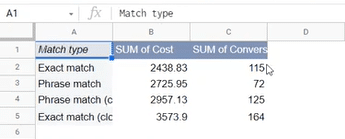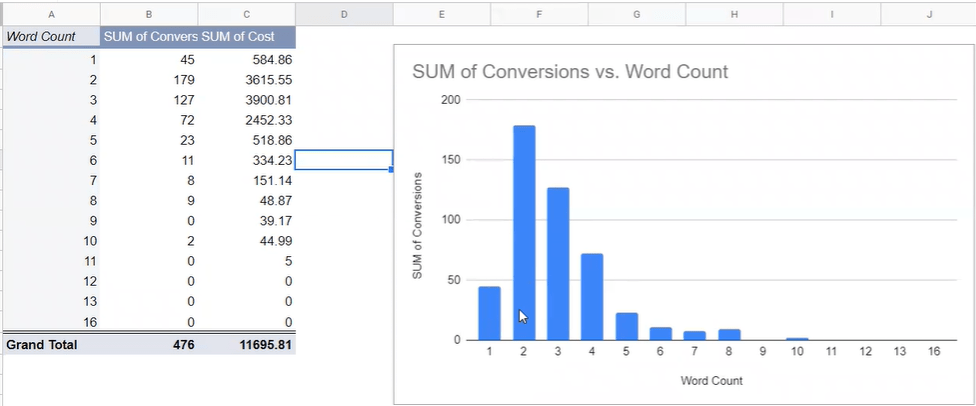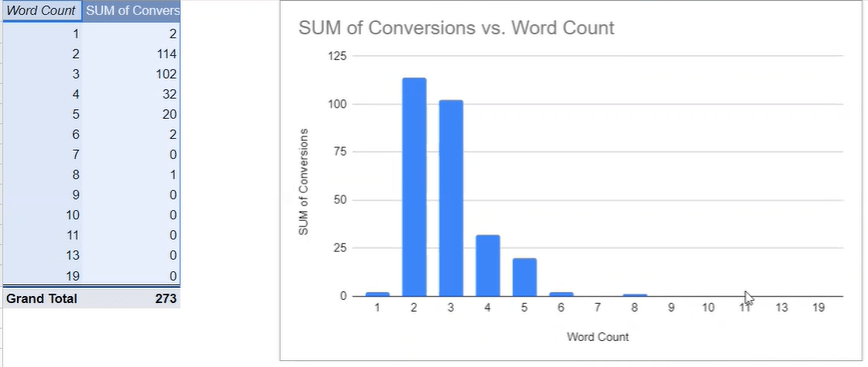
There are many rumours in the digital marketing world about the best way to optimize and improve Google Ads accounts. We are here to dispel a few of those rumours and show you 4 tied and true ways to improve your Google Ads account performance today.
1. Watch Your Match Types
This section will go over how to use pivot tables to get the best performance out of different keyword match types.
If you’re running a Google Ads campaign, and you add broad match keywords, how do you know if the broad match keywords are performing well in comparison to your exact match and phrase match?
You might think the answer is either looking at the cost per conversion or cost-per-click (CPC) compared to the same term in phrase match or exact match to see which one has a cheaper CPC.
This is correct, but there is a faster and better way!
What you need to do first is pull up the search term report and export it.
After you download the search terms report, open it in either Excel or Google Sheets and remove the summary rows.
Next, create a pivot table by:
- Select the entire data set.
- Insert → Pivot Table → New Sheet → Create.
- Select Match Type and place it into Rows.
- Select Cost and place it into Values.
- Select Conversion and place it into Values.
- Under Match Type, Sort by: SUM of Cost.
- Uncheck Show totals.
You should now get a table that looks like this:

What you can see here is each match type, its spend, and the associated conversions.
You’ll end up seeing a breakdown of the different kinds of matches as well as performance.
Now, you can check to see which search terms are converting by taking the following steps:
- Add a Search term into Rows below Match type.
- Sort by the SUM of Conversions, descending.
- Remove Show totals.
You can now see which search terms or keywords are converting along with their costs, sorted by the number of conversions.
If you are using broad match (not recommended), you can add broad match under the match type in the pivot table and see which keywords should probably be added as phrase match or exact match. If the SUM of cost is 0 after a month or two, you should definitely remove all your broad matches permanently.
2. Conversions by Word Count
Contrary to popular belief, the sweet spot range for conversions is between 2 and 5 words. This section will go over when to exclude search terms by word count.
One of the myths right now is that when you create a Google Ads account, you should focus on low competition phrase match search terms and that the goal is to get low cost per click. While this may work for some fields, such as those that are highly technical, it rarely outperforms focused in-market product and service terms.
However, a lot of digital marketers don’t know what the Competition index is.
The Competition index represents the number of competitors, and oftentimes, the number of inventory slots on Google search. It is an index value that is based on the competitiveness of a search term and is referring to a combination of supply and demand for ad inventory on any given search and associated variables.
If you look for any keyword, you’ll be given a value between zero and one. Being an index value, it’s always a decimal point. The lower end of that spectrum means that if there’s no demand and therefore, Google provides little-to-no supply. In short, that means that there are no current inventory slots on that keyword, which also means that there’s a good chance no one has advertised there or if they have, there’s just not much competition or value for other companies to advertise. While new markets (supply and demand) emerge every day, this generally holds true for most markets.
When it’s on the lower end of the spectrum, it often means that there are two ad slots, so anything below about 0.3. If it’s in the middle end of the spectrum, it usually means that there are four ad slots. And if it’s on the higher end of the spectrum, it means there are up to eight ad slots. And so you can tell simply by looking at a keyword. Keep in mind, Google can adjust inventory at any time to increase auction prices and it does so automatically.
For most keywords, where the high range is a very small number (e.g. below 5), it will usually have one or two ad slots.
For example, if you search “flower delivery in Vancouver”, you will see it has a high competition value. Arguably, it should have seven or eight ad slots and that often holds true.
Now try one that’s low. Search “flower factory Vancouver”. This search would be considered low competition and has no paid ad slots.
There’s a myth right now that you should focus on longer phrases to get conversions. The reality is that this is not the case for most businesses. Try for yourself though.
Perform a word count analysis, where you add a word count column calculation in Google Sheets. If you add the word count column and you do a pivot table, you’ll find that almost every company in every industry has this exact same pattern where anything with two – five search terms usually converts. Anything beyond that performs much poorer. Once again, some industries, such as SAAS and travel are the exception where in-market searches are very specific and much longer.

All in all, your money is much better placed anywhere between the two and five-word range (as seen above). And that same thing can be said when you optimize for keywords.
We can take this knowledge a step further though. A lot of people ask what the ideal keyword length is when writing website content. Well, the core pages of a website should be between two and five. And anything that is more informational or geared towards the blog can be longer.
Here is another example of a pivot table for a different company where you find the same pattern. This is standard across the board.

What you should do is create a negative keyword list on the account and just call it something like “search terms too long” or “search terms too specific”. Then, exclude anything beyond six words because the chances of getting a conversion are exponentially slim.
But if you put them in the negative keyword list, you can still run top-of-funnel campaigns without being negatively impacted.
Overall, long-tail keywords are not always optimistic for conversions.
3. Use Google My Business Search Terms

Have you updated the URL inside Google My Business to include the UTM (Urchin Tracking Module) parameters?
In Google My Business, click on Info, and then website and add UTM parameters. For example: https://example.ca/?utm_source=google&utm_medium=local. Click Apply.
Now in your Google Search Console, you’ll start to see the actual keywords that this business listing shows up for. And it’s incredibly valuable because it gives you a much better view of what search terms your business listing is ranking for.
By default, Google Search Console will report all traffic from Google My Business under the page it’s using, which most often is the homepage.
You can also get the same insights another way though.
In Google Business Profile Manager, go to “Insights” → “See new profile performance”. Scroll down, you’ll see a report, with a search terms breakdown. You can click on “See more” and see the top 10 search terms your business listing is showing up for. So if you want to see more than that, you just need to add those UTM parameters to the search terms report.
This is a great way to identify new keywords that are very likely to convert.
4. YouTube Search Terms in Google Ads

This section will go over search terms exclusions for YouTube. Oh yes, it’s a thing!
In Google Ads, go to Reports → Predefined reports → Display/Video → YouTube search terms.
When you run display campaigns and video campaigns, they contain search terms that you will most definitely want to exclude and clean up. And the reality is, a huge portion of the search terms are spam and things that you don’t want to be advertising on.
Under Impr. → sort by high to low. What you’ll find is that a large portion of these have a couple of similarities that cost you a lot of money. So, when you want to clean up your YouTube search terms, it is highly recommended to come out with your own list. But you’ll generally find that there are a vast number of YouTube search terms you don’t want your advertising to show up for that should be excluded. This will help cleave large parts away from the ad spend.
We often exclude gaming, topics for children, music videos, and more.
Overall, you can improve your Google Ads account performance by using pivot tables to detect efficiency, optimizing word count in search terms, using Google My Business search terms, and by eliminating certain search terms on YouTube facing campaigns. As any good marketer should do, try these experiments yourself and stay tuned for more.
Need help optimizing your Google Ads? 1UP Digital Marketing has expertise in Google Ads, tracking & analytics, and can help improve your account performance with real results. You can also learn more about our PPC (Paid Ads) services.
Let us know how we can help you 1UP your digital marketing with our web marketing services below:
